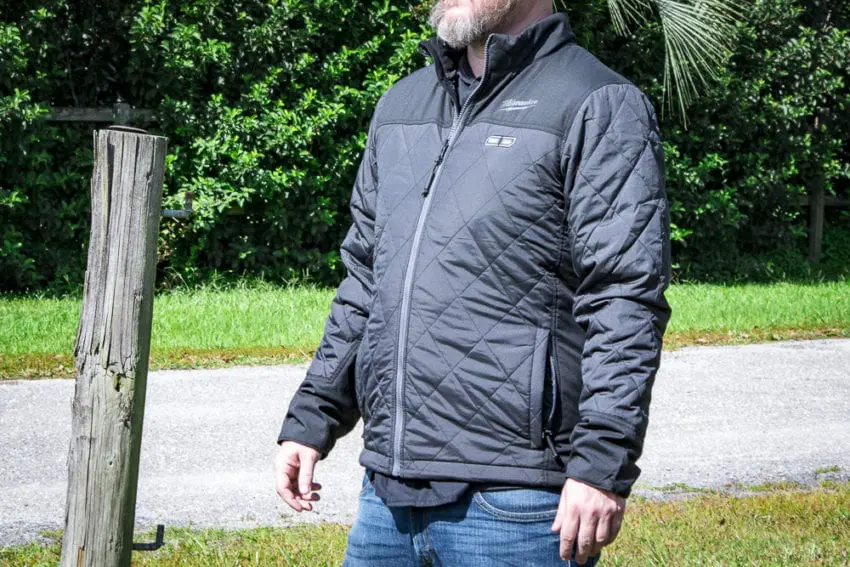The work doesn’t stop when it gets frigid outside, so it’s nice that we’ve finally reached a point in human history where we can throw on one of any number of heated jacket options. Instead of a regular jacket keeping all of your self-generated body warmth contained, the heated jacket does the heavy lifting from the heating side of things. Some heated jackets work better than others, as we found out in our recent Heated Jacket Shootout. The Milwaukee Axis Heated Jacket, the winner of our shootout, falls into that better-working category. Let’s take a look at what sets it apart.
Pros
- Accurate fit according to the size chart
- Most comfortable heated jacket overall
- Excellent insulation effectiveness
- Excellent heating times
- 5 heating zones, including left/right shoulders
- Excellent value rating
- Side entry battery pocket is more accessible than others
Cons
- Outer shell isn’t as durable as thicker shells
- No belt clip on the battery holster
Recommendation
If you’re looking for the most comfortable heated jacket, the Milwaukee Axis is your winner. While the outer shell has ripstop stitching, it is less durable than the thicker ones running around, so keep that in mind.
Feature Set
Heat Zones and Controls
The Milwaukee Axis Heated Jacket has its controls located on the left chest. Two buttons allow the user discrete control over the 5 heating elements located in the left and right chest sections, left and right shoulder sections, and across the back. You won’t find shoulder heat zones on most heated jackets and it helps to surround your core more completely.

Battery Storage
The battery has the potential to really affect the comfortability factor of the design. Thankfully, Milwaukee uses a 12V battery here. While you won’t get the same runtimes as you would with an 18V battery, the 12V won’t add as much bulk or weight. In fact, the Milwaukee Axis Heated Jacket’s design almost eliminates the feeling that you’re toting around a battery at all.
The battery fits into a pocket on the rear left and has a side entry that’s much easier to access than other heated jackets. There’s also a point in the center back that you can run the cord if you’d like to shift the battery off the jacket completely and into a rear pocket.

Material and Design
The Milwaukee Axis uses a slick-feeling, 100% polyester inner lining and outer shell. Personally, I prefer this material to the rougher-feeling, fleecier materials. It slides on and off without bunching up your base layer and compresses nicely.

The downside to the outer material is that it won’t be as durable as some of the other jacket materials out there. However, it does come with ripstop stitching and makes adding another layer easy if you want the Axis to act as mid-layer.
Where nearly every other jacket opts for hook and loop straps or storm cuffs, the Axis features some light elastic. The sleeves won’t block the elements the same way that storm cuffs do, but they are more comfortable than hook and loop straps.

Milwaukee Axis Heated Jacket Additional Features
- Quick-heat function acts like a preheat, getting the jacket up to temperature quickly
- One-touch LED controller with (3) heat settings per heat zone
- Washer and dryer safe
- Wind & water-resistant
- Compressible design
- Reinforced high-wear zones protect from abrasion and tears
- 100% polyester insulation keeps heat in without adding bulk
- Adjustable waist with drop tail extended back
- 2 outer zip pockets, 1 inner zip pocket, 1 low-profile battery pocket
Fit
While we tend to look at fit more subjectively, we do have objective benchmarks to look at for this category. For all workwear, that has everything to do with how accurate the sizing chart is.
The size chart doesn’t tell you everything, though. How does a jacket fit over your shoulders and midsection? How long are the sleeves? Does the jacket have enough length to keep your stomach covered when reaching over your head?

The chest sizes Milwaukee recommends are dead-on, fitting me across the shoulders perfectly. The sleeve length is excellent as well. The midsection and length are on the short side, though. Any reaching exposes my stomach and the fit is tighter than I prefer.
The tighter fit is something you’ll need to decide on. It keeps the heating elements close to your skin where it does the most good but takes some getting used to. This is not unique to Milwaukee and every jacket we tested has very similar fit characteristics. Our recommendation across the board is to try it on before you pull the tags off in case you want to go up a size.
Things Are Heating Up
Temperature
While design and comfort are important qualities for any heated jacket, the ability to heat is the entire reason for buying one.
We tested how long each jacket took to reach 100°. In its highest setting, the Milwaukee Axis sprung to life almost immediately, reaching the 100° mark in just 11 seconds. That’s just 1 second shy of Bosch’s winning time of 10 seconds.
It took the jacket 92 seconds to reach its max temperature at 140°, and which point it backed down to its “cruising temperature” of 131°. Only Bosch has a higher overall temperature at 152° with a 140° cruising temp and DeWalt matches the Axis at 131° once it settles in.

We also wanted to know how well each jacket keeps the heat in. After one hour of the jacket set to high, we compared the difference in temperature between the outside shell and the inside temperature. The Axis performed well compared to the other jackets, though there weren’t wild swings between any of them. It allows 72% of its internal temperature to escape. Makita’s new Hi-Viz did slightly better with 71% escaping, while their Camp model punched in with a 79% escape rate.
Battery Efficiency

With a combination of battery capacities and voltages, we looked at a couple of metrics. The Milwaukee Axis runs for an impressive 2 hours, 50 minutes with all heat zones on high and 3 hours, 51 minutes with the chest and back elements on high.
Comparing the full-zone runtime to the 2.0 Ah M12 battery that comes with the kit, the Axis is right in the middle when it comes to how efficiently it uses those watts.
Pricing
The Milwaukee Axis Heated Jacket retails for $219, and it comes with an M12 RedLithium 2.0 Ah battery pack and compact charger. You can also pick up the jacket by itself for $169. This price is comparable to most of the other jackets we tested and it earns 4.9 stars for its value.
The Bottom Line
From an objective standpoint, the Milwaukee Axis Heated Jacket performed consistently well, though it never ran away with the show. From a more subjective place, this jacket seems like the biggest crowd-pleaser for our team. It can function as a middle or outer layer, it’s comfortable as all get out, the battery isn’t terribly obtrusive, it gets warm fast and stays there. All things considered, it’s easy to recommend the Milwaukee Axis to anyone looking to stay warm on the job site.
Milwaukee Axis Heated Jacket Specs
- Model Number: Milwaukee 203-21
- Voltage: 12V
- Battery System: M12
- Heat Settings: High, Medium, and Low
- Washing: Washer and Dryer Safe
- Weather Resistant: Wind/Water-Resistant
- Insulated: Yes
- Heat Elements: Chest, Back, Shoulders
- Inner Material: Brushed Tricot
- Heated Gear Warranty: 1-Year
- Price: $179 bare, $219 kit



